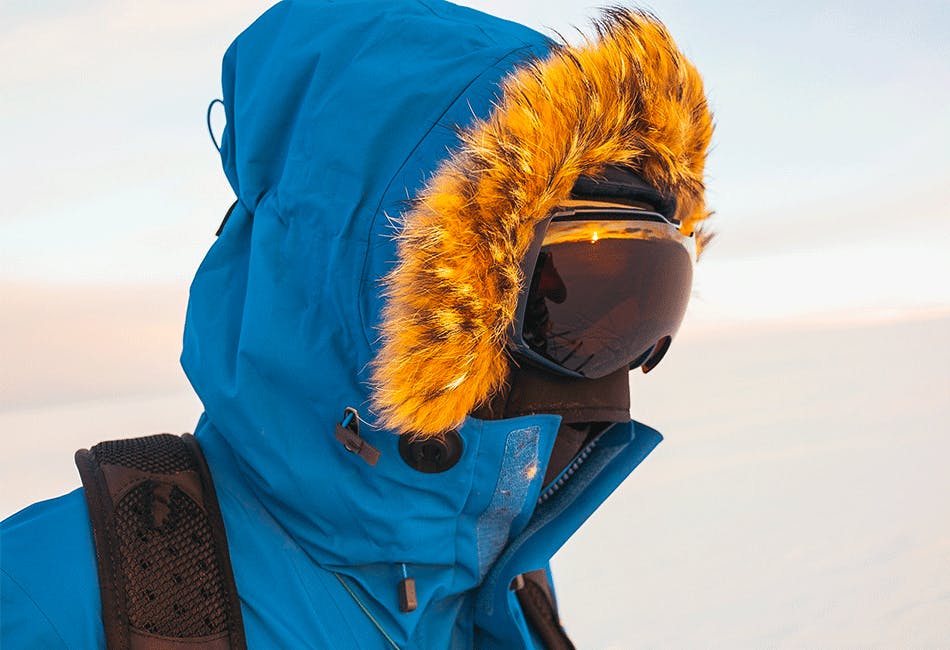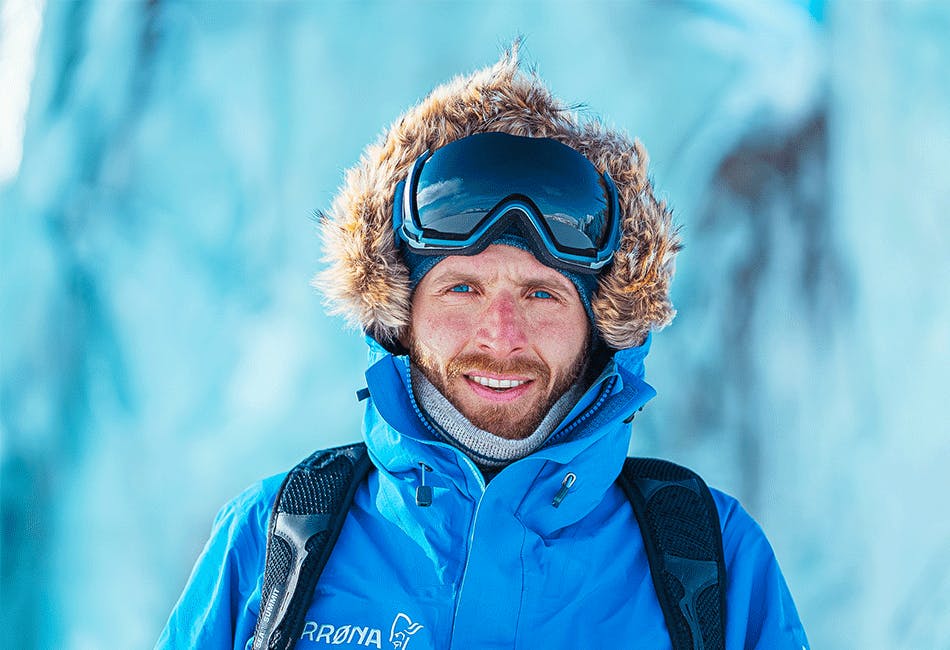Mission accomplished for a winter first in the Arctic

Crossing the entire length of Spitsbergen.
It was on 2 February 2021 that I and my partner Caroline Côté, adventure filmmaker and ultra-marathon athlete who I met on a ski expedition in Antarctica, began the start of a winter crossing over the vast and wild lands of Svalbard. For more than 2 months and over a distance of more than 1,100 km without any form of assistance, we had to call on the qualities of discipline, audacity and endurance to achieve the goal we’d set ourselves: the first north-south crossing of the main island of Spitsbergen in the depths of the polar winter. We started and finished in the town of Longyearbyen to avoid having to use any motorized form of transport to get to the northern end of the island or to get picked up from its southern tip. It was a highly unusual expedition that risked endangering our lives and the love that unites us.

This amazing adventure started in Longyearbyen, the administrative capital of Svalbard and the northernmost town in the world. After picking up last-minute parcels, we left civilization to undertake this incredible 63-day adventure, pulling two sleds each with a total weight of over 290 kg. We were fully prepared to meet the king of Svalbard, the polar bear. There’s a population of around 3,500 bears here, a third more than the number of inhabitants on the archipelago. We also met the famous and iconic Svalbard reindeer and the arctic fox, an endangered species on the island.
The polar night left us very little room for error. The possibility of coming face to face with a bear was a constant threat. We encountered two of them on our journey. The effects of global warming in recent years have modified the topography of the island. In this rapidly changing environment, the southern glaciers were fissured with dangerous crevasses when we travelled over them. Hunger was another major challenge of the expedition, tormenting us from the beginning to the very end of the trip. We had to ration our food for much of the journey so we could make it through to the end. This major challenge almost cost us dearly and by the end of the expedition we were seriously underweight and lacking in energy. But the beauty of this ice world, framed by the aurora borealis and glaciers, gave us the necessary strength to complete our journey. We celebrated the end of this amazing expedition in the presence of the famous Norwegian polar explorer Børge Ousland who came to Longyearbyen to congratulate us on accomplishing our mission.

Product test: new REACTIV 0-4 lens
“I wore the new Julbo photochromic and ventilated lens which goes from category 0 to category 4. At the beginning of the expedition, we traveled for more than 20 hours in the dark, and at the end for almost 20 hours in daylight. I wore the goggles regardless of the temperature: from -38°C during the periods of highest pressure to 1°C on the warmest days. I’ll definitely be taking these goggles with me on future expeditions.”

Expedition highlights:
- 2 February, Departure from Longyearbyen in darkness in the depths of the Arctic winter; total weight of the sleds divided between Caroline and I at the start: 290 kg;
- 10 February, We escape from the Filchner icecap (-30°C with an easterly wind) in order to:
- Avoid frost–ite - my feet are suffering;
- Take advantage of the ice in the Widjefjord or its coast to get to the north more quickly; - 14 February, We get stuck in Widjefjord and can’t move any further north:
- Lack of ice in the fjord;
- Not enough snow on the edges of the fjord (a high chance of breaking the sleds on the many rocks);
- We have to turn around to get back onto the icecap; - 15 February, We retrace our steps:
- We meet a bear and ski just a hundred meters away from it;
- After about 10 km, we enter a valley heading towards the Smuts glacier; - 16 February, We travel up a partially frozen river and get back to the heights; 1000 m of ascent in the middle of the mountains of Atom Fjellet.
- 19 February, We see the sun for a few seconds and for the first time on the Åsgargfonna icecap;
- 22 February, We reach Verlegehuken, the northern tip of the island, after a push of 42 km; it’s the starting point of our attempt to make the first winter crossing of Spitsbergen. The aim is to reach the South Cape before 21 March, the first day of spring;
- 15 March, It’s -38°C this morning in the tent vestibule on the Hamberg glacier; Lars Ebbessen announces the arrival of an enormous mass of warm air in the coming days. We press on to get as close as possible to the South Cape;
- 18 March, Crossing of Isbukta Bay (Ice Bay in Norwegian). 11 km of pack ice in a straight line. The weather is warm and it’s strangely calm while we cross the bay. A cloudy front is gradually approaching. The weather deteriorates at the end of the day. We stop to camp on dry land right at the edge of the pack ice. We have to work fast before it’s too late to set up camp!
- Night of 19 March, Caroline wakes up to find the tent buried under snow. We have to shovel hard until morning! Before setting off, we allow ourselves a 50-minute nap. We’re exhausted, but so close to our goal! Less than 40 km separate us from our objective. The inside of the tent is wet; it’s–0°C - a temperature difference of almost 40 degrees from 3 days ago! We have to store our equipment inside our vapour barriers as we didn’t bring waterproof bags with us (the vapour barrier is similar to a garbage bag that we sleep in every night to prevent body condensation from contaminating our sleeping bags. Without it, all the condensation would turn to pieces of ice inside the sleeping bag). We’ve never experienced such extreme changes in temperature! We put our skis back on and continue like two zombies. We can’t ski more than 12 km before being forced to set up camp again.
- 20 March, “You guys should go early in the morning! It’s gonna get bad later!”. On receiving this short message, we hurry to leave the Sorkappfonna icecap. Despite difficulty getting the tent down (the poles are enveloped in ice), today we have to give our all to reach Sørneset, the southern tip of the island. It’s the last day of winter! The wind picks up and the clouds roll over the tops of the mountains. The situation gets so dangerous that we can no longer stand upright in the moraine of the Matthiasbreen glacier. There’s no question of trying to pull our sleds in such a fierce wind! So we have to head due south to get out of this area and then readjust the route to reach Sørneset. A mass of threatening cloud is forming off the South Cape in seas strewn with ice and battered by winds coming off the icecap.
- 20 March, 1.15 pm. We did it! We’ve been on this unassisted expedition for 47 days and it’s 27 days since we left Verlegehuken, the northern tip of the island! It’s 1.15 pm. We’ve completed the first unassisted north-south winter crossing of Spitsbergen! With a mixture of fear, joy and exhaustion, we sit just under the cairn of Sørneset, protected by our emergency tarp. We share our GPS position. But we have to wait for 4 days at the South Cape before heading north again. Outside, the weather is just too violent!
- 24 March, We resume our journey. 250 km separate us from Longyearbyen, our final destination.
- 25 March, We’re forced to take yet another diversion! To our great surprise, the ice of Isbukta is completely broken up giving way to areas of open water, a deadly trap without a dry suit or raft. At the end of the day, we have to rope ourselves together through a tricky pass, the “Isryggpasset”, that we navigate under bright blue seracs!
- 26 March to 4 April:
- 7 km, the shortest distance travelled due to violent winds;
- We’re at rock bottom: the lack of energy, calories and sleep make us very weak;
- A final blast of wind with gusts of 30 m/s as we approach Longyearbyen. “We had to battle right to the end! But we made it!”
- 5 April, We ski the last 4 km. Our foreheads touching and with little left to say, we try to take in what we’ve just achieved.
- 10 April, the Norwegian legend of polar exploration, Børge Ousland, comes to congratulate us.

Ombres Polaires / Polar Shadows
- 63 days
- 1000 km
- Unassisted
- A winter first in the Arctic
- North-south crossing of the Spitsbergen archipelago
- Start and finish in Longyearbyen
- 3,500 polar bears on the archipelago, a third more than the number of inhabitants
- Total weight of the 4 sleds: 290 kg
- 5,000 to 6,000 calories per day consumed by each adventurer
- 2 polar bears encountered en route
- Temperatures ranging from 0°C to -40°C
- Expedition from 2 February to 5 April 2021
Vincent Colliard bio
With a passion for exploration, French adventurer Vincent Colliard, 35, is one of the most accomplished polar explorers of our generation. His many expeditions include the ongoing project Ice Legacy, in which he aims to cross the 20 largest icecaps on the planet. He represents a new type of athlete eager to bridge the gap between adventure and science, and to inspire respect for the environment on a worldwide scale.
Caroline Côté bio
Caroline Côté, 34, is a professional Canadian adventurer, filmmaker and adventure photographer based in Montreal. Her role on past expeditions has been to capture images that are then screened to the general public in the form of documentaries. A passionate fan of endurance challenges involving running, kayaking and skiing, she already has several demanding expeditions under her belt.



